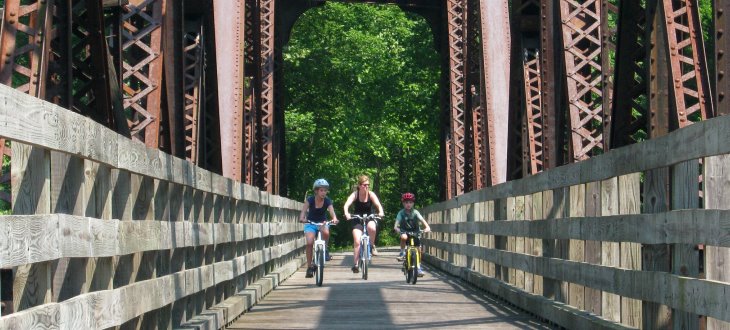The State We're In
Recycling the rails of New Jersey’s past
All over the United States, abandoned railways have been finding new life. Once the arteries of America’s industrial expansion, these rail lines carried commuters, and commerce. But as the automobile took over in the mid-20th century, thousands of miles of track fell silent. By 1963, more than 50,000 miles of railway were unused and overgrown.
Fortunately, that loss became an opportunity when people looking to spend more time outdoors realized that these long, smooth, and relatively flat corridors offered perfect conditions for walking, cycling, and connecting communities.
A recent PBS documentary, From Rails to Trails, explores how the national movement to make trails from railroad lines was born and grew. It’s a story of vision and persistence by citizens, planners, and conservationists who refused to let old rail lines be sold off piecemeal or lost to neglect. Instead, they seized on the potential for corridors to safely link neighborhoods, protect green space, and provide everyone a chance to enjoy the outdoors close to home.
The idea is as practical as it is poetic. But early efforts at transforming these corridors weren’t easy. It required political will, legal innovation, and above all, collaboration. The 1983 federal “Railbanking Act” signed by Ronald Reagan was a turning point, allowing unused rail corridors to be preserved for possible future rail transportation while being converted to public trails in the meantime.
In the decades since, the “rails-to-trails” idea has become a nationwide success story. The concept inspired the formation of the Rails-to-Trails Conservancy which works to connect communities across the nation through trails and trail networks. Its leadership has opened people’s eyes to what’s possible when we reimagine what we already have.
There are now more than 25,000 miles of completed rail-trails across the country, with thousands more in the works! These paths have proven to be powerful engines of local economic growth – revitalizing downtowns, boosting tourism, and raising property values – while also offering free, safe, and sustainable recreation opportunities.
In New Jersey, that transformation is visible from Sussex to Cape May. Our state boasts 60 rail-trails totaling more than 350 miles, each one a living piece of repurposed history.
In the documentary, former U.S. Transportation Secretary Pete Buttigieg notes that “the beginning and end of a trail doesn’t respect the beginning and end of a county line or a city limit. So there needs to be regional cooperation.” That’s especially true in New Jersey, where population density and fragmented development make continuous green space both precious and rare.
The East Coast Greenway, the Delaware River Heritage Trail, and the Delaware & Raritan Canal State Park are inspirational examples of regional trails with segments of rail-trails that give residents and visitors new and greener ways of traveling around the region. Cities like Camden and Trenton are becoming hubs in this network, and as new sections are completed, the value of the entire system multiplies.
Preserving historic railbeds stitches together communities and ecosystems that might otherwise remain isolated. These linear parks provide carbon free recreation and transportation opportunities and are inherently well suited for people with mobility challenges. They also serve as green infrastructure, absorbing stormwater, providing wildlife corridors, and reducing the urban heat-island effect. Many rail trails preserve a tangible link to our industrial heritage: when you walk along portions of the Delaware & Raritan Canal State Park Trail, you’re tracing the same routes that once carried coal and clay to power New Jersey’s factories. Former mills and old train stations – and plenty of historic homes – enhance the journey.
The rails-to-trails movement began with dedicated people who refused to let progress erase a valuable resource of the past. That same spirit is alive today in New Jersey among local volunteers maintaining trails, advocates pushing for new connections, and residents choosing to explore their communities by foot or bike rather than by car. So hit the trails this holiday season for some recreation, inspiration and a taste of New Jersey history!
To watch the Rails to Trails documentary with friends and family, please visit https://www.pbs.org/show/from-rails-to-trails/.
To learn more about how you can help preserve New Jersey’s natural resources, visit the New Jersey Conservation Foundation at www.njconservation.org or reach out to us at info@njconservation.org.
About the Authors
Alison Mitchell
Executive Director
Michele S. Byers
Executive Director, 1999-2021
John S. Watson, Jr.
Co-Executive Director, 2022-2024
Tom Gilbert
Co-Executive Director, 2022-2023
View their full bios here.
Filter
Get The Latest News
From The Garden State
In the
News

